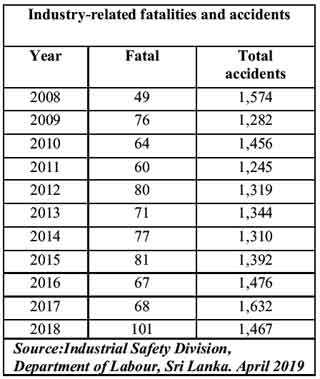Wednesday Apr 23, 2025
Wednesday Apr 23, 2025
Thursday, 27 June 2019 01:05 - - {{hitsCtrl.values.hits}}

More than 374 million people are injured or made ill every year through work-related accidents. The International Labour Organization (ILO) Country Office for Sri Lanka and the Maldives, together with the Ministry of Labour and Trade Union Relations, Department of Labour, National Institute of Occupational Safety and Health (NIOSH), Employers’ Federation of Ceylon (EFC) and trade unions will hold an event on Occupational Safety and Health at work today in Colombo. 
The ILO’s global theme for Occupational Safety and Health this year is ‘Safety and Health at the heart of the Future of Work’.
In its centenary year the ILO launched an accompanying publication ‘Safety and Health at the heart of the Future of Work: Building on 100 years of experience’. This report brings to light emerging challenges in terms of health and safety issues in the world of work, and identifies opportunities in creating better working environments.
Changes in working practices, demographics, technology and the environment are creating new occupational safety and health (OSH) concerns. Growing challenges include psychosocial risks, work-related stress and non-communicable diseases, notably circulatory and respiratory diseases, and cancers.
“The fast-changing world of work poses the question as to how the OSH field would approach new challenges and opportunities. Rapid changes taking place with advancing technologies are revolutionising the workplace. The OSH concerns that arise with these changes need to be addressed in an efficient and timely manner,” commented Employers’ Federation of Ceylon (EFC) Deputy Director General Vajira Ellepola.
It is estimated that work days lost to OSH-related causes represent almost 4% of global GDP, in some countries as much as 6%, according to the ILO.
“As well as the economic cost we must recognise the immeasurable human suffering such illnesses and accidents cause. These are all-the-more tragic because they are largely preventable,” said ILO Sri Lanka and the Maldives Country Director Simrin Singh. “Occupational safety and health must be centre stage of national efforts to achieve a brighter future of work for all,” added Singh.
In Sri Lanka it is a requirement under the Factories Ordinance to report fatal and non-fatal accidents to the Industrial Safety Division of the Department of Labour. According to the Labour Department’s Industrial Safety Division, on average 1,300 to 1,500 non-fatal accidents are being reported annually which results in 500,000 man days lost. However, there is a critical need to improve OSH data collection and analysis for informed policy making and practice.
“Occupational safety and health has become a high priority in a world in which more lives are lost and more people are injured due to industrial accidents than natural disasters. There are emerging health issues arising due to new methods used in the world of work, and as trade unions, this is a key concern for us,” stated Sri Lanka Nidhahas Sevaka Sangamaya General Secretary Leslie Devendra.
Looking to the future through an OSH lens, the ILO publication highlights four major transformative forces driving changes. It points out that all also offer opportunities for improvements.
First, technology, such as digitisation, robotics, and nanotechnology, can also affect psychosocial health and introduce new materials with unmeasured health hazards. Correctly applied it can also help reduce hazardous exposures, facilitate training and labour inspections.
Demographic shifts are important because young workers have significantly higher occupational injury rates, while older workers need adaptive practices and equipment to work safely. Women – who are entering the workforce in increasing numbers – are more likely to have non-standard work arrangements and have a higher risk of musculoskeletal disorders.
“The ageing population, the expected increased participation of female workers and the evolving forms of employment relationships are bound to create their own unique challenges in the field of OSH,” noted Vajira Ellepola of the Employers’ Federation.
Thirdly, development and climate change give rise to risks such as air pollution, heat stress, emerging diseases, shifting weather and temperature patterns that can bring job losses. Equally, new jobs will be created through sustainable development and the green economy.
Finally, changes in the organisation of work can bring flexibility that allows more people to enter the labour force, but may also lead to psychosocial issues such as insecurity, compromised privacy and rest time, or inadequate OSH and social protections, and excessive work hours. Approximately 36% of the world’s workforce currently works excessive hours (more than 48 hours per week).
In light of these challenges the ILO study proposes concrete areas on which policymakers and other stakeholders should focus. These include more foresight analysis of new and emerging OSH risks, adopting a more multidisciplinary approach and building stronger links to public health work.
Better public understanding of OSH issues is also needed. Finally, international labour standards and national legislation need to be strengthened, something which will require stronger partnership between governments, workers and employers.
“Enforcing laws to improve Occupational Safety and Health is essential, but that alone will not be sufficient. Therefore, the Department of Labour encourages both the employers and workers to improve OSH at their workplaces, and comply with OSH laws voluntarily – creating an OSH culture which is essential for safety of the workers and productivity improvement,” said Commissioner General of Labour, Sri Lanka Ananda Wimalaweera.
The world of work is undergoing rapid changes. This transformation necessitates work towards a future where the utmost is done to ensure the safety and health of the world’s workers. It is important for governments, employers and workers, and other stakeholders to create a safe and healthy future of work for all. A shared commitment to learn, protect and prevent occupational hazards will instil a culture of safety and health for the benefit of everyone.
Discover Kapruka, the leading online shopping platform in Sri Lanka, where you can conveniently send Gifts and Flowers to your loved ones for any event including Valentine ’s Day. Explore a wide range of popular Shopping Categories on Kapruka, including Toys, Groceries, Electronics, Birthday Cakes, Fruits, Chocolates, Flower Bouquets, Clothing, Watches, Lingerie, Gift Sets and Jewellery. Also if you’re interested in selling with Kapruka, Partner Central by Kapruka is the best solution to start with. Moreover, through Kapruka Global Shop, you can also enjoy the convenience of purchasing products from renowned platforms like Amazon and eBay and have them delivered to Sri Lanka.
Discover Kapruka, the leading online shopping platform in Sri Lanka, where you can conveniently send Gifts and Flowers to your loved ones for any event including Valentine ’s Day. Explore a wide range of popular Shopping Categories on Kapruka, including Toys, Groceries, Electronics, Birthday Cakes, Fruits, Chocolates, Flower Bouquets, Clothing, Watches, Lingerie, Gift Sets and Jewellery. Also if you’re interested in selling with Kapruka, Partner Central by Kapruka is the best solution to start with. Moreover, through Kapruka Global Shop, you can also enjoy the convenience of purchasing products from renowned platforms like Amazon and eBay and have them delivered to Sri Lanka.